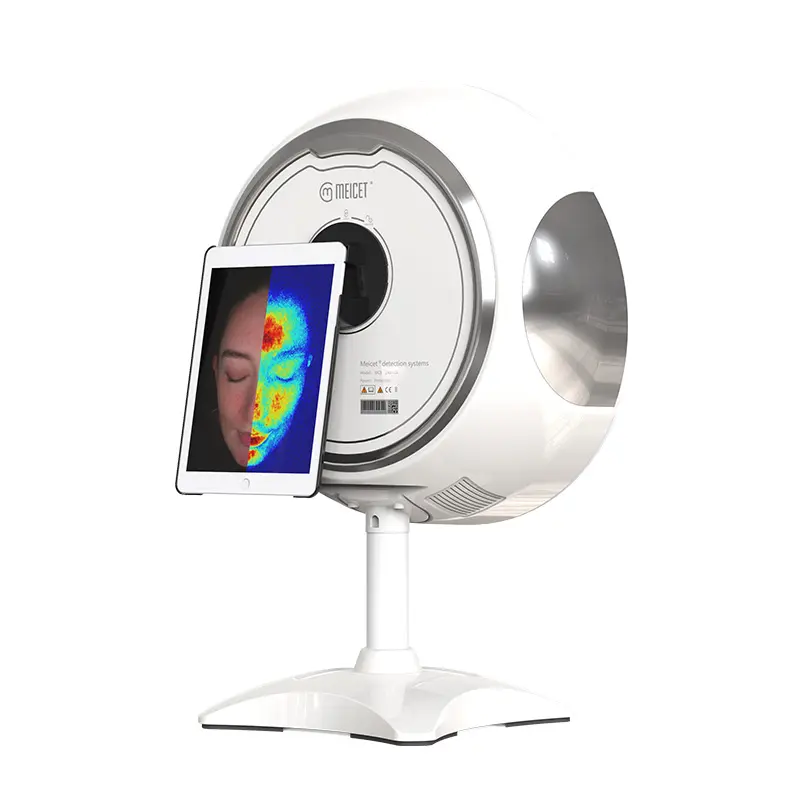
Micro-needling has emerged as a versatile anti-aging tool, stimulating collagen production to reduce wrinkles, improve texture, and enhance skin elasticity. Its success, however, depends on more than the procedure itself: clinicians must monitor healing to ensure proper collagen synthesis, avoid over-treatment, and adjust protocols based on individual response. For patients, particularly those with busy schedules or limited access to clinics, frequent in-person follow-ups can be burdensome, risking delays in care or premature re-treatment. MEICET’s MC10 Portable Skin Analyzer addresses this by enabling remote monitoring of post-micro-needling progress, ensuring optimal timing and intensity for wrinkle reduction while enhancing patient convenience.

Assessing Healing and Barrier Recovery
Micro-needling creates controlled micro-injuries in the dermis, triggering a healing cascade that includes inflammation, epithelialization (re-epithelialization of the epidermis), and collagen remodeling. Proper healing is critical for collagen synthesis—disruption (e.g., infection, excessive dryness) can impair results or cause scarring. The MC10’s imaging captures key healing milestones, even in remote settings:
- RGB imaging tracks epithelialization, the process by which the outer skin layer regenerates. In the early days post-treatment, RGB scans show micro-crusting and mild redness—normal signs of healing. Later, scans should reveal uniform re-epithelialization with reduced crusting; persistent crusting in localized areas signals delayed healing, prompting targeted moisturization or antibiotic ointment.
- UV imaging evaluates barrier integrity, which is temporarily compromised by micro-needling. In the first week, UV scans show irregular fluorescence (consistent with barrier disruption). As time passes, improving uniformity indicates the stratum corneum is rebuilding—essential for preventing transepidermal water loss and irritation.
- Polarized light imaging detects residual inflammation, which peaks early and should subside over time. Persistent redness in polarized mode later suggests excessive inflammation, which can impair collagen production and increase PIH risk. This finding guides the addition of anti-inflammatory serums (e.g., centella asiatica) to support healing.
Consider a patient with forehead wrinkles treated with micro-needling, followed by MC10 scans at a satellite clinic:
- Early on: RGB shows expected crusting, UV confirms barrier disruption, polarized light reveals mild inflammation—all normal.
- Later: RGB shows crusts resolved, UV shows improving barrier uniformity, polarized light redness reduced—healing on track.
- Much later: RGB shows smooth texture, UV nearly uniform (barrier restored), polarized light no residual inflammation—cleared for next session when ready.
This remote monitoring ensures the patient avoids unnecessary in-clinic visits while confirming healing is progressing properly.
Monitoring Collagen-Driven Texture Improvements
Collagen synthesis from micro-needling unfolds over time, with gradual improvements in wrinkle depth and skin tightness continuing for months. The MC10’s imaging captures these subtle changes, providing objective evidence of treatment efficacy:
- RGB imaging maps wrinkle depth and texture, comparing pre-treatment scans to follow-ups. Fine lines appear as “valleys” in RGB mode; post-treatment, these valleys become shallower as new collagen fills them. A patient with periorbital lines may have later scans showing shallower wrinkles in RGB mode—confirming the micro-needling is stimulating desired collagen growth.
- Polarized light imaging indirectly assesses collagen density by detecting improved skin tightness. As collagen accumulates, the dermis becomes more compact, reducing vascular visibility in polarized mode. Reduced redness in treated areas later signals tighter, healthier skin—correlating with improved elasticity.
- UV imaging tracks overall radiance, as increased collagen improves light reflection. A patient with dull skin pre-treatment may have later UV scans showing more uniform light scattering—indicating a brighter, more youthful complexion.
A patient with cheek wrinkles undergoes micro-needling and remote MC10 monitoring:
- After some time: RGB shows subtle improvement in wrinkle depth, polarized light reveals reduced vascularity (early collagen signs).
- Later: RGB confirms shallower wrinkles, polarized light redness reduced—collagen synthesis active.
- Much later: RGB shows significant texture improvement, UV reveals brighter, more uniform skin—treatment success confirmed.
This data reinforces patient confidence, as they can visualize progress even when changes are too subtle to notice in a mirror.
Personalizing Session Intervals and Parameters
Micro-needling intervals and needle depth vary by patient, based on skin thickness, wrinkle severity, and healing speed. The MC10’s data enables personalized adjustments:
- Patients with robust healing (barrier restored in due time, minimal inflammation) and clear collagen signs (reduced wrinkle depth later) can proceed with standard intervals.
- Those with slower healing (persistent barrier issues) or signs of over-stimulation (increased redness) need extended intervals to avoid cumulative damage.
- Needle depth may be adjusted based on response: patients with deeper wrinkles showing good tolerance may benefit from longer needles in subsequent sessions, while sensitive skin with mild wrinkles may do better with shorter needles.
For example, a patient with thick skin and deep nasolabial folds shows rapid healing and clear collagen response on MC10 scans, justifying standard intervals with appropriate needle length. In contrast, a patient with thin, sensitive skin and fine lines requires extended intervals with shorter needles—balancing efficacy and safety.
The MC10 Portable Skin Analyzer transforms post-micro-needling care by making remote monitoring both precise and convenient. By tracking healing, confirming collagen growth, and personalizing intervals, it ensures patients receive optimal anti-aging results while minimizing barriers to care—ultimately enhancing satisfaction and adherence to treatment plans.
 EN
EN
 AR
AR
 BG
BG
 HR
HR
 CS
CS
 DA
DA
 NL
NL
 FI
FI
 FR
FR
 DE
DE
 EL
EL
 HI
HI
 IT
IT
 JA
JA
 KO
KO
 NO
NO
 PL
PL
 PT
PT
 RO
RO
 RU
RU
 ES
ES
 SV
SV
 TL
TL
 IW
IW
 ID
ID
 SR
SR
 SK
SK
 SL
SL
 UK
UK
 VI
VI
 SQ
SQ
 HU
HU
 TH
TH
 TR
TR
 FA
FA
 AF
AF
 MS
MS
 UR
UR
 BN
BN
 LA
LA

